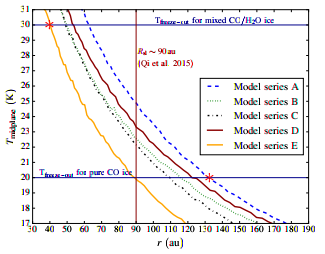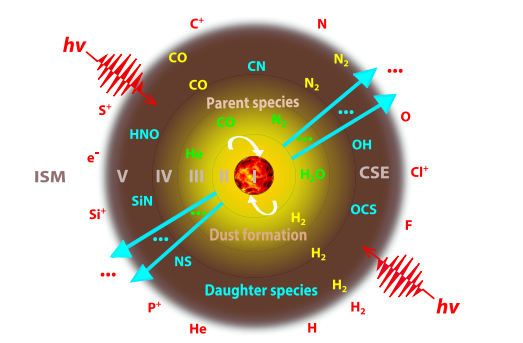Molecular Astrophysics

models that match with observed SED. The models are generated by varying parameters based on CO molecular line observations by ALMA. In dark red vertical line is the observed snowline radius and the horizontal blue lines are the upper and lower limits of the freeze-cut temperature. The red astrisks indicate where the snowline location could be due to a plausible range of freeze-out temperatures if the snowline location was not known unambiguously from observations. Figure from: Boneberg D.M. et al. 2016, MNRAS, 461, 385.
The Astrophysics Group is very active in obtaining molecular line observations of protoplanetary discs and developing theoretical models to exploit them to understand the dynamics and chemical compositions of the discs. The line observations enable measurements of the gas velocities in different parts of discs. The comparisons of the compositions of a variety of regions in discs with the compositions of the dark clouds in which stellar birth occurs, oceans, and planetary atmospheres as well as other solar system objects, such as comets, yield insight into how discs, planets, and the other solar system objects form. Observational and theoretical investigations of the distributions of complex organic molecules in discs and solar system objects may even bear on the origin of life.

The Astrophysics Group has worked and continues to work on a wide range of molecular astrophysical sources. These include shocks driven by the outflows of young stars, the outflows of very evolved oxygen-rich AGB stars, and even the region near the central supermassive black hole of the largest galaxy in a cluster of galaxies. In the shocks, some of which may induce sequential star formation, the injection of material into the gas phase by the destruction of dust triggers a rich chemistry. In contrast dust is formed in the outflows of some evolved stars. At present the knowledge of terrestrial combustion processes has led to insight into the production of dust in carbon-rich outflows. However, the understanding of the routes to the sand-like silicate and other metallic particles in oxygen-rich outflows remains primitive. The response of dust formed in AGB stars to the pressure due to the stellar radiation fields affects the mass loss rates and outflow speeds, and some of the dust becomes a significant component of protoplanetary discs.
Suggested Reading
 The Cosmic-Chemical Bond
The Cosmic-Chemical Bond
Chemistry from the Big Bang to Planet Formation
By D.A. Williams and T.W. Hartquist
Published May 2013, 214 pages
RSC Publishing
